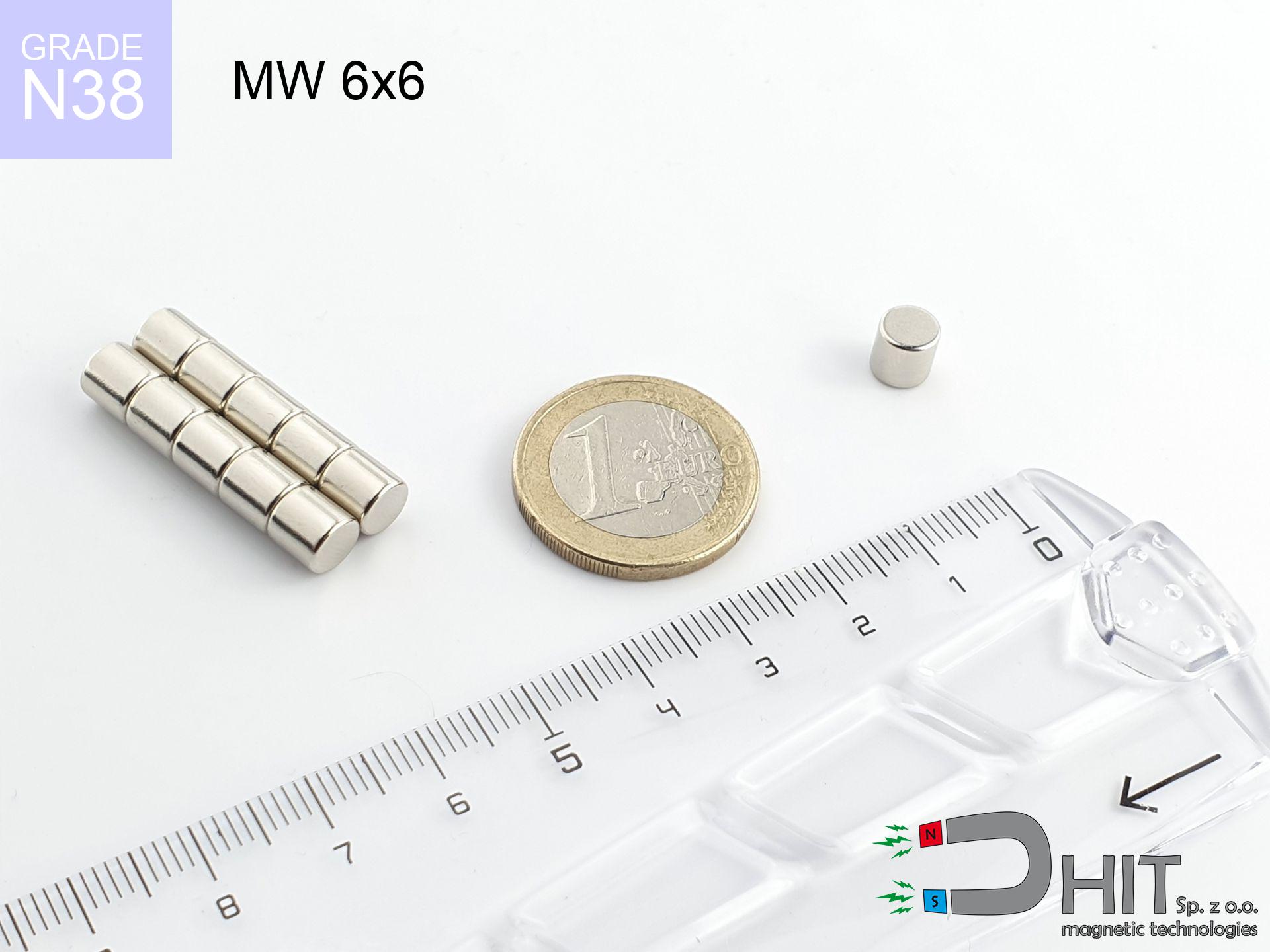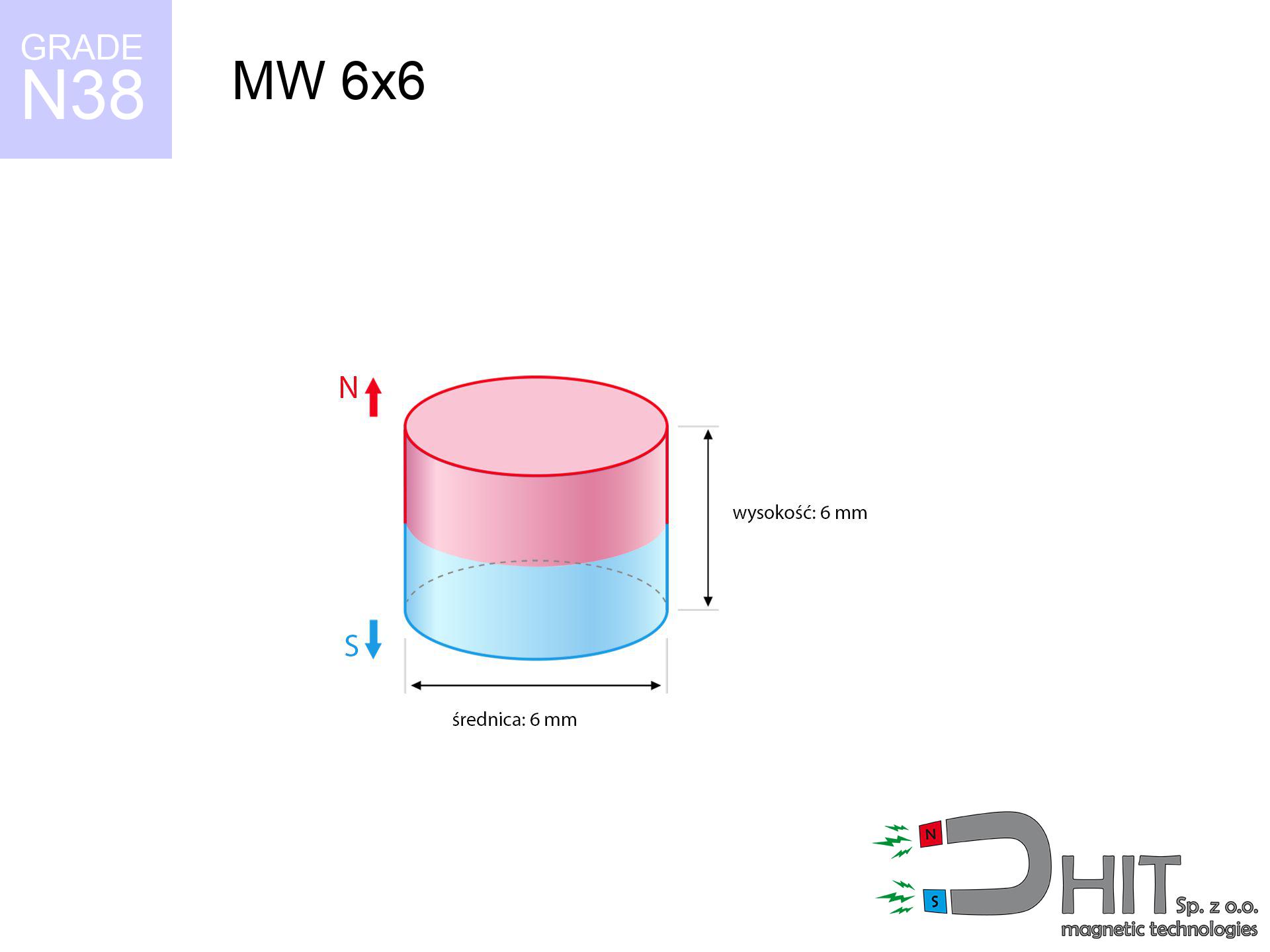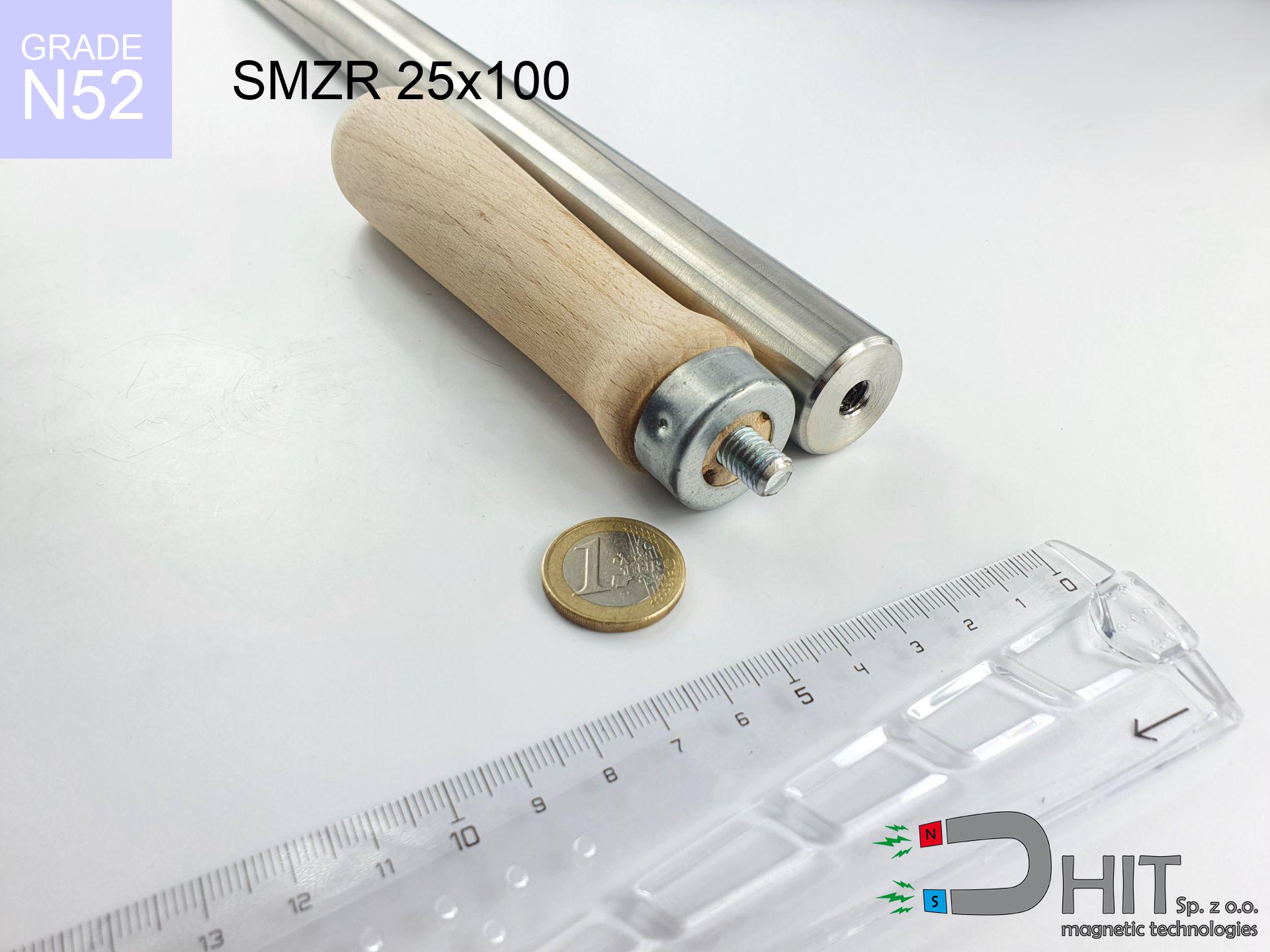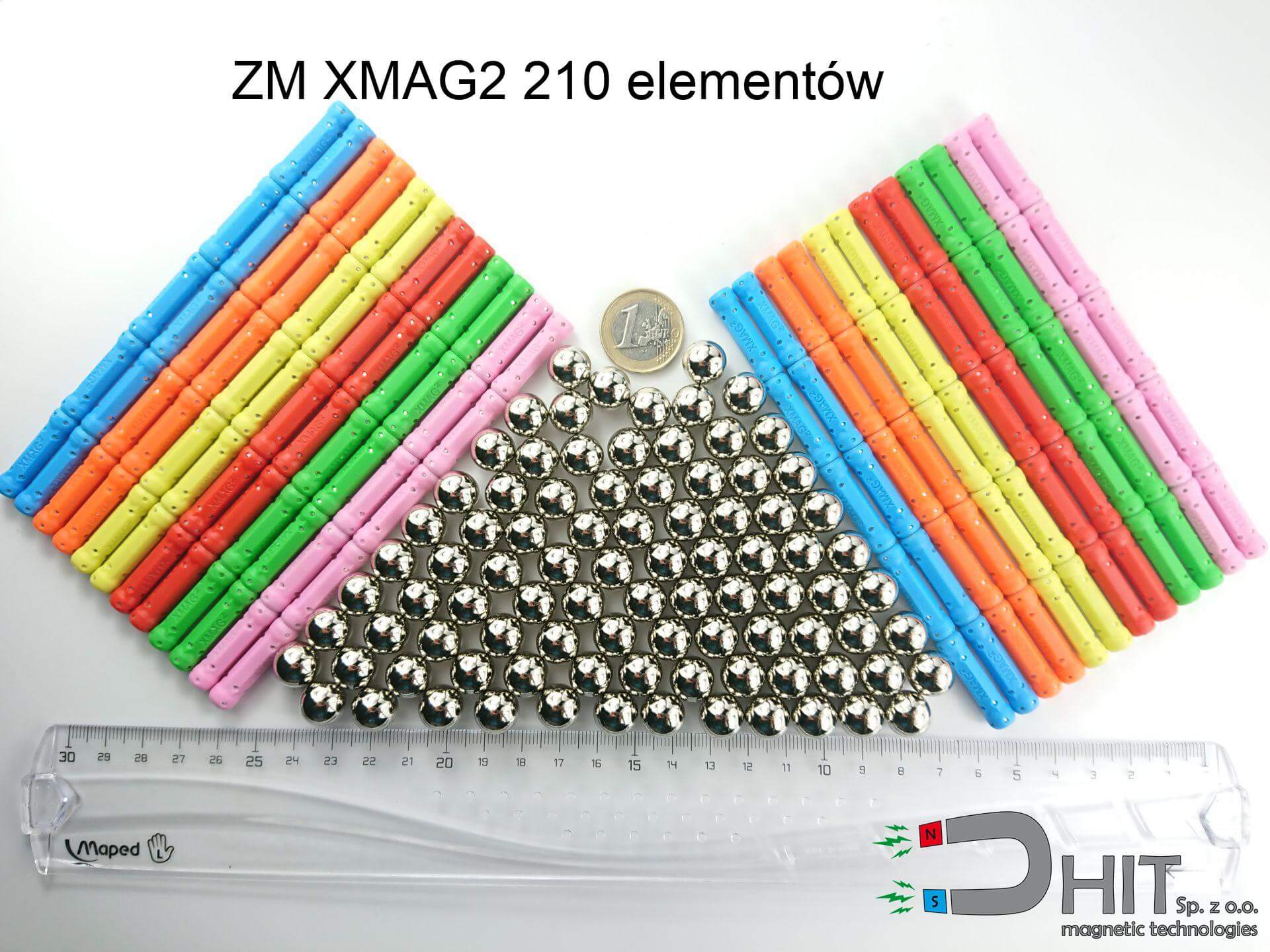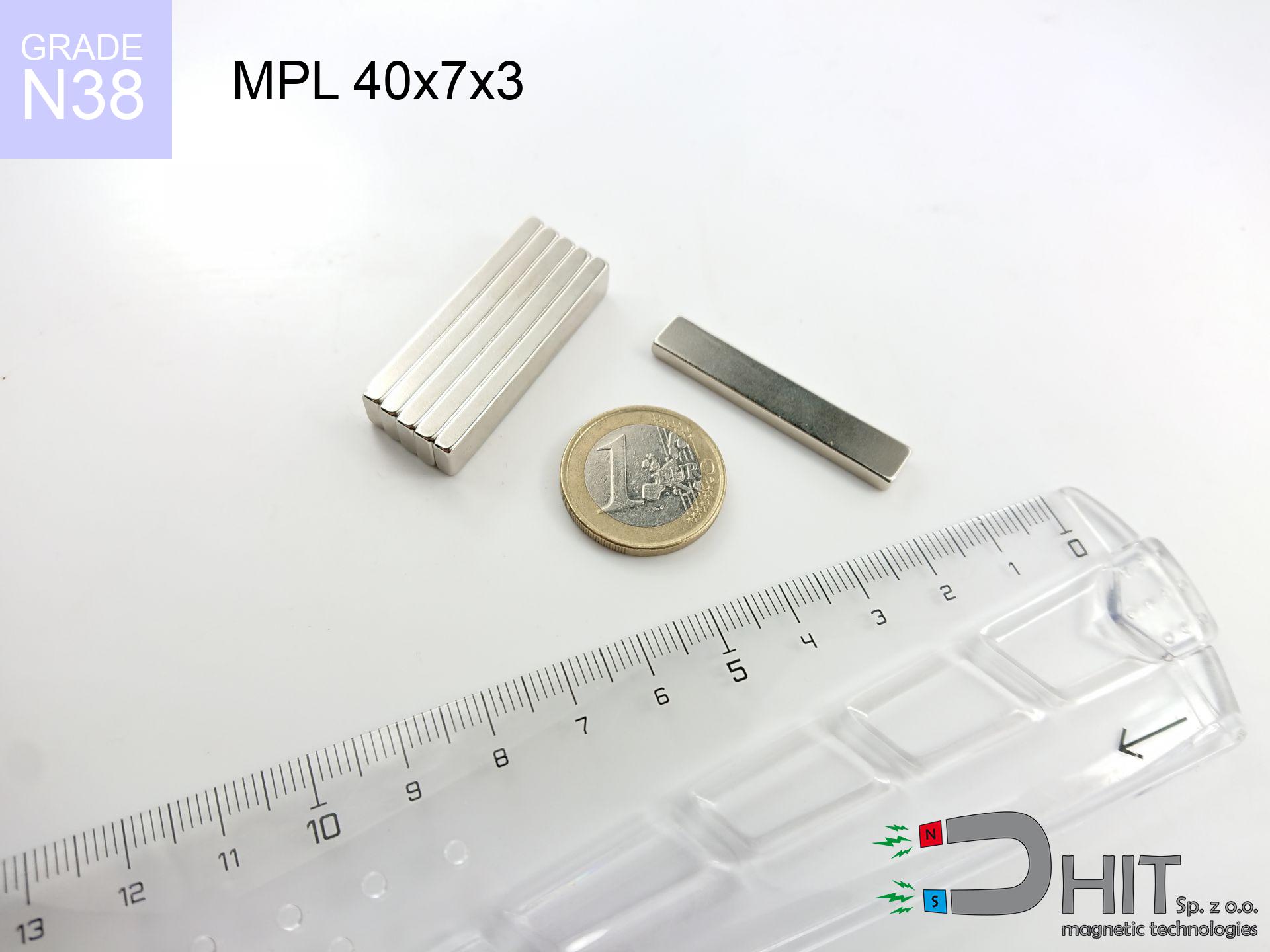MW 6x6 / N38 - cylindrical magnet
cylindrical magnet
Catalog no 010094
GTIN/EAN: 5906301810933
Diameter Ø
6 mm [±0,1 mm]
Height
6 mm [±0,1 mm]
Weight
1.27 g
Magnetization Direction
↑ axial
Load capacity
1.14 kg / 11.18 N
Magnetic Induction
553.38 mT / 5534 Gs
Coating
[NiCuNi] Nickel
0.677 ZŁ with VAT / pcs + price for transport
0.550 ZŁ net + 23% VAT / pcs
bulk discounts:
Need more?
Pick up the phone and ask
+48 22 499 98 98
if you prefer get in touch by means of
form
the contact page.
Specifications as well as structure of a magnet can be tested with our
our magnetic calculator.
Same-day shipping for orders placed before 14:00.
Product card - MW 6x6 / N38 - cylindrical magnet
Specification / characteristics - MW 6x6 / N38 - cylindrical magnet
| properties | values |
|---|---|
| Cat. no. | 010094 |
| GTIN/EAN | 5906301810933 |
| Production/Distribution | Dhit sp. z o.o. |
| Country of origin | Poland / China / Germany |
| Customs code | 85059029 |
| Diameter Ø | 6 mm [±0,1 mm] |
| Height | 6 mm [±0,1 mm] |
| Weight | 1.27 g |
| Magnetization Direction | ↑ axial |
| Load capacity ~ ? | 1.14 kg / 11.18 N |
| Magnetic Induction ~ ? | 553.38 mT / 5534 Gs |
| Coating | [NiCuNi] Nickel |
| Manufacturing Tolerance | ±0.1 mm |
Magnetic properties of material N38
| properties | values | units |
|---|---|---|
| remenance Br [min. - max.] ? | 12.2-12.6 | kGs |
| remenance Br [min. - max.] ? | 1220-1260 | mT |
| coercivity bHc ? | 10.8-11.5 | kOe |
| coercivity bHc ? | 860-915 | kA/m |
| actual internal force iHc | ≥ 12 | kOe |
| actual internal force iHc | ≥ 955 | kA/m |
| energy density [min. - max.] ? | 36-38 | BH max MGOe |
| energy density [min. - max.] ? | 287-303 | BH max KJ/m |
| max. temperature ? | ≤ 80 | °C |
Physical properties of sintered neodymium magnets Nd2Fe14B at 20°C
| properties | values | units |
|---|---|---|
| Vickers hardness | ≥550 | Hv |
| Density | ≥7.4 | g/cm3 |
| Curie Temperature TC | 312 - 380 | °C |
| Curie Temperature TF | 593 - 716 | °F |
| Specific resistance | 150 | μΩ⋅cm |
| Bending strength | 250 | MPa |
| Compressive strength | 1000~1100 | MPa |
| Thermal expansion parallel (∥) to orientation (M) | (3-4) x 10-6 | °C-1 |
| Thermal expansion perpendicular (⊥) to orientation (M) | -(1-3) x 10-6 | °C-1 |
| Young's modulus | 1.7 x 104 | kg/mm² |
Technical modeling of the magnet - data
Presented values represent the result of a mathematical calculation. Results are based on models for the material Nd2Fe14B. Real-world performance might slightly differ. Treat these calculations as a reference point when designing systems.
Table 1: Static force (pull vs gap) - power drop
MW 6x6 / N38
| Distance (mm) | Induction (Gauss) / mT | Pull Force (kg) | Risk Status |
|---|---|---|---|
| 0 mm |
5527 Gs
552.7 mT
|
1.14 kg / 1140.0 g
11.2 N
|
weak grip |
| 1 mm |
3738 Gs
373.8 mT
|
0.52 kg / 521.5 g
5.1 N
|
weak grip |
| 2 mm |
2366 Gs
236.6 mT
|
0.21 kg / 209.0 g
2.0 N
|
weak grip |
| 3 mm |
1498 Gs
149.8 mT
|
0.08 kg / 83.7 g
0.8 N
|
weak grip |
| 5 mm |
665 Gs
66.5 mT
|
0.02 kg / 16.5 g
0.2 N
|
weak grip |
| 10 mm |
155 Gs
15.5 mT
|
0.00 kg / 0.9 g
0.0 N
|
weak grip |
| 15 mm |
58 Gs
5.8 mT
|
0.00 kg / 0.1 g
0.0 N
|
weak grip |
| 20 mm |
28 Gs
2.8 mT
|
0.00 kg / 0.0 g
0.0 N
|
weak grip |
| 30 mm |
9 Gs
0.9 mT
|
0.00 kg / 0.0 g
0.0 N
|
weak grip |
| 50 mm |
2 Gs
0.2 mT
|
0.00 kg / 0.0 g
0.0 N
|
weak grip |
Table 2: Sliding hold (vertical surface)
MW 6x6 / N38
| Distance (mm) | Friction coefficient | Pull Force (kg) |
|---|---|---|
| 0 mm | Stal (~0.2) |
0.23 kg / 228.0 g
2.2 N
|
| 1 mm | Stal (~0.2) |
0.10 kg / 104.0 g
1.0 N
|
| 2 mm | Stal (~0.2) |
0.04 kg / 42.0 g
0.4 N
|
| 3 mm | Stal (~0.2) |
0.02 kg / 16.0 g
0.2 N
|
| 5 mm | Stal (~0.2) |
0.00 kg / 4.0 g
0.0 N
|
| 10 mm | Stal (~0.2) |
0.00 kg / 0.0 g
0.0 N
|
| 15 mm | Stal (~0.2) |
0.00 kg / 0.0 g
0.0 N
|
| 20 mm | Stal (~0.2) |
0.00 kg / 0.0 g
0.0 N
|
| 30 mm | Stal (~0.2) |
0.00 kg / 0.0 g
0.0 N
|
| 50 mm | Stal (~0.2) |
0.00 kg / 0.0 g
0.0 N
|
Table 3: Vertical assembly (sliding) - behavior on slippery surfaces
MW 6x6 / N38
| Surface type | Friction coefficient / % Mocy | Max load (kg) |
|---|---|---|
| Raw steel |
µ = 0.3
30% Nominalnej Siły
|
0.34 kg / 342.0 g
3.4 N
|
| Painted steel (standard) |
µ = 0.2
20% Nominalnej Siły
|
0.23 kg / 228.0 g
2.2 N
|
| Oily/slippery steel |
µ = 0.1
10% Nominalnej Siły
|
0.11 kg / 114.0 g
1.1 N
|
| Magnet with anti-slip rubber |
µ = 0.5
50% Nominalnej Siły
|
0.57 kg / 570.0 g
5.6 N
|
Table 4: Steel thickness (substrate influence) - sheet metal selection
MW 6x6 / N38
| Steel thickness (mm) | % power | Real pull force (kg) |
|---|---|---|
| 0.5 mm |
|
0.11 kg / 114.0 g
1.1 N
|
| 1 mm |
|
0.29 kg / 285.0 g
2.8 N
|
| 2 mm |
|
0.57 kg / 570.0 g
5.6 N
|
| 5 mm |
|
1.14 kg / 1140.0 g
11.2 N
|
| 10 mm |
|
1.14 kg / 1140.0 g
11.2 N
|
Table 5: Working in heat (stability) - resistance threshold
MW 6x6 / N38
| Ambient temp. (°C) | Power loss | Remaining pull | Status |
|---|---|---|---|
| 20 °C | 0.0% |
1.14 kg / 1140.0 g
11.2 N
|
OK |
| 40 °C | -2.2% |
1.11 kg / 1114.9 g
10.9 N
|
OK |
| 60 °C | -4.4% |
1.09 kg / 1089.8 g
10.7 N
|
OK |
| 80 °C | -6.6% |
1.06 kg / 1064.8 g
10.4 N
|
|
| 100 °C | -28.8% |
0.81 kg / 811.7 g
8.0 N
|
Table 6: Two magnets (repulsion) - field range
MW 6x6 / N38
| Gap (mm) | Attraction (kg) (N-S) | Repulsion (kg) (N-N) |
|---|---|---|
| 0 mm |
5.32 kg / 5324 g
52.2 N
5 995 Gs
|
N/A |
| 1 mm |
3.70 kg / 3705 g
36.3 N
9 220 Gs
|
3.33 kg / 3334 g
32.7 N
~0 Gs
|
| 2 mm |
2.44 kg / 2436 g
23.9 N
7 476 Gs
|
2.19 kg / 2192 g
21.5 N
~0 Gs
|
| 3 mm |
1.55 kg / 1552 g
15.2 N
5 968 Gs
|
1.40 kg / 1397 g
13.7 N
~0 Gs
|
| 5 mm |
0.61 kg / 614 g
6.0 N
3 755 Gs
|
0.55 kg / 553 g
5.4 N
~0 Gs
|
| 10 mm |
0.08 kg / 77 g
0.8 N
1 330 Gs
|
0.07 kg / 69 g
0.7 N
~0 Gs
|
| 20 mm |
0.00 kg / 4 g
0.0 N
311 Gs
|
0.00 kg / 0 g
0.0 N
~0 Gs
|
| 50 mm |
0.00 kg / 0 g
0.0 N
31 Gs
|
0.00 kg / 0 g
0.0 N
~0 Gs
|
Table 7: Protective zones (electronics) - warnings
MW 6x6 / N38
| Object / Device | Limit (Gauss) / mT | Safe distance |
|---|---|---|
| Pacemaker | 5 Gs (0.5 mT) | 4.0 cm |
| Hearing aid | 10 Gs (1.0 mT) | 3.0 cm |
| Mechanical watch | 20 Gs (2.0 mT) | 2.5 cm |
| Mobile device | 40 Gs (4.0 mT) | 2.0 cm |
| Car key | 50 Gs (5.0 mT) | 2.0 cm |
| Payment card | 400 Gs (40.0 mT) | 1.0 cm |
| HDD hard drive | 600 Gs (60.0 mT) | 1.0 cm |
Table 8: Dynamics (cracking risk) - collision effects
MW 6x6 / N38
| Start from (mm) | Speed (km/h) | Energy (J) | Predicted outcome |
|---|---|---|---|
| 10 mm |
30.23 km/h
(8.40 m/s)
|
0.04 J | |
| 30 mm |
52.34 km/h
(14.54 m/s)
|
0.13 J | |
| 50 mm |
67.56 km/h
(18.77 m/s)
|
0.22 J | |
| 100 mm |
95.55 km/h
(26.54 m/s)
|
0.45 J |
Table 9: Corrosion resistance
MW 6x6 / N38
| Technical parameter | Value / Description |
|---|---|
| Coating type | [NiCuNi] Nickel |
| Layer structure | Nickel - Copper - Nickel |
| Layer thickness | 10-20 µm |
| Salt spray test (SST) ? | 24 h |
| Recommended environment | Indoors only (dry) |
Table 10: Electrical data (Flux)
MW 6x6 / N38
| Parameter | Value | SI Unit / Description |
|---|---|---|
| Magnetic Flux | 1 613 Mx | 16.1 µWb |
| Pc Coefficient | 0.89 | High (Stable) |
Table 11: Submerged application
MW 6x6 / N38
| Environment | Effective steel pull | Effect |
|---|---|---|
| Air (land) | 1.14 kg | Standard |
| Water (riverbed) |
1.31 kg
(+0.17 kg Buoyancy gain)
|
+14.5% |
1. Vertical hold
*Warning: On a vertical surface, the magnet retains only ~20% of its perpendicular strength.
2. Efficiency vs thickness
*Thin steel (e.g. computer case) drastically reduces the holding force.
3. Power loss vs temp
*For N38 grade, the critical limit is 80°C.
4. Demagnetization curve and operating point (B-H)
chart generated for the permeance coefficient Pc (Permeance Coefficient) = 0.89
This simulation demonstrates the magnetic stability of the selected magnet under specific geometric conditions. The solid red line represents the demagnetization curve (material potential), while the dashed blue line is the load line based on the magnet's geometry. The Pc (Permeance Coefficient), also known as the load line slope, is a dimensionless value that describes the relationship between the magnet's shape and its magnetic stability. The intersection of these two lines (the black dot) is the operating point — it determines the actual magnetic flux density generated by the magnet in this specific configuration. A higher Pc value means the magnet is more 'slender' (tall relative to its area), resulting in a higher operating point and better resistance to irreversible demagnetization caused by external fields or temperature. A value of 0.42 is relatively low (typical for flat magnets), meaning the operating point is closer to the 'knee' of the curve — caution is advised when operating at temperatures near the maximum limit to avoid strength loss.
Material specification
| iron (Fe) | 64% – 68% |
| neodymium (Nd) | 29% – 32% |
| boron (B) | 1.1% – 1.2% |
| dysprosium (Dy) | 0.5% – 2.0% |
| coating (Ni-Cu-Ni) | < 0.05% |
Ecology and recycling (GPSR)
| recyclability (EoL) | 100% |
| recycled raw materials | ~10% (pre-cons) |
| carbon footprint | low / zredukowany |
| waste code (EWC) | 16 02 16 |
Other deals
Strengths as well as weaknesses of Nd2Fe14B magnets.
Pros
- They have stable power, and over around ten years their performance decreases symbolically – ~1% (according to theory),
- They feature excellent resistance to magnetism drop when exposed to external fields,
- The use of an metallic coating of noble metals (nickel, gold, silver) causes the element to look better,
- Neodymium magnets deliver maximum magnetic induction on a small surface, which increases force concentration,
- Made from properly selected components, these magnets show impressive resistance to high heat, enabling them to function (depending on their form) at temperatures up to 230°C and above...
- Thanks to freedom in forming and the capacity to modify to specific needs,
- Versatile presence in future technologies – they are commonly used in mass storage devices, drive modules, precision medical tools, as well as other advanced devices.
- Compactness – despite small sizes they offer powerful magnetic field, making them ideal for precision applications
Weaknesses
- They are fragile upon heavy impacts. To avoid cracks, it is worth securing magnets in a protective case. Such protection not only shields the magnet but also increases its resistance to damage
- When exposed to high temperature, neodymium magnets suffer a drop in power. Often, when the temperature exceeds 80°C, their strength decreases (depending on the size, as well as shape of the magnet). For those who need magnets for extreme conditions, we offer [AH] versions withstanding up to 230°C
- Due to the susceptibility of magnets to corrosion in a humid environment, we suggest using waterproof magnets made of rubber, plastic or other material immune to moisture, in case of application outdoors
- Due to limitations in producing threads and complex shapes in magnets, we propose using cover - magnetic mechanism.
- Potential hazard resulting from small fragments of magnets can be dangerous, in case of ingestion, which becomes key in the context of child safety. It is also worth noting that small elements of these products can be problematic in diagnostics medical after entering the body.
- High unit price – neodymium magnets cost more than other types of magnets (e.g. ferrite), which can limit application in large quantities
Lifting parameters
Best holding force of the magnet in ideal parameters – what affects it?
- using a sheet made of high-permeability steel, acting as a circuit closing element
- possessing a massiveness of minimum 10 mm to avoid saturation
- with an ground contact surface
- with zero gap (without coatings)
- during pulling in a direction vertical to the plane
- in stable room temperature
Determinants of lifting force in real conditions
- Space between surfaces – every millimeter of separation (caused e.g. by varnish or unevenness) diminishes the magnet efficiency, often by half at just 0.5 mm.
- Load vector – maximum parameter is obtained only during pulling at a 90° angle. The resistance to sliding of the magnet along the plate is usually many times lower (approx. 1/5 of the lifting capacity).
- Metal thickness – thin material does not allow full use of the magnet. Magnetic flux penetrates through instead of generating force.
- Material composition – different alloys reacts the same. High carbon content worsen the interaction with the magnet.
- Surface quality – the more even the surface, the better the adhesion and higher the lifting capacity. Unevenness acts like micro-gaps.
- Temperature – heating the magnet causes a temporary drop of induction. Check the maximum operating temperature for a given model.
Lifting capacity was determined by applying a smooth steel plate of optimal thickness (min. 20 mm), under perpendicular pulling force, however under attempts to slide the magnet the load capacity is reduced by as much as 75%. Additionally, even a slight gap between the magnet and the plate lowers the holding force.
Safe handling of NdFeB magnets
Do not overheat magnets
Do not overheat. NdFeB magnets are susceptible to heat. If you need resistance above 80°C, ask us about HT versions (H, SH, UH).
Mechanical processing
Mechanical processing of NdFeB material carries a risk of fire risk. Magnetic powder oxidizes rapidly with oxygen and is difficult to extinguish.
Powerful field
Before starting, read the rules. Uncontrolled attraction can break the magnet or hurt your hand. Be predictive.
GPS Danger
Navigation devices and mobile phones are highly susceptible to magnetism. Direct contact with a strong magnet can permanently damage the internal compass in your phone.
Warning for allergy sufferers
Warning for allergy sufferers: The Ni-Cu-Ni coating contains nickel. If an allergic reaction appears, immediately stop working with magnets and use protective gear.
Adults only
Adult use only. Small elements pose a choking risk, leading to serious injuries. Store away from kids and pets.
Hand protection
Protect your hands. Two powerful magnets will snap together instantly with a force of several hundred kilograms, crushing anything in their path. Be careful!
Threat to electronics
Intense magnetic fields can destroy records on payment cards, hard drives, and other magnetic media. Keep a distance of at least 10 cm.
Magnet fragility
Beware of splinters. Magnets can fracture upon violent connection, launching shards into the air. We recommend safety glasses.
Warning for heart patients
Medical warning: Strong magnets can deactivate heart devices and defibrillators. Stay away if you have electronic implants.


